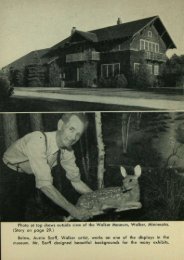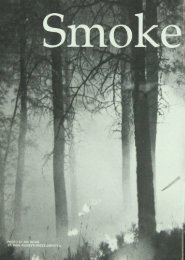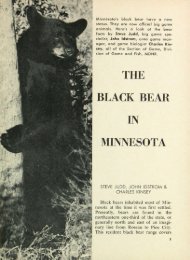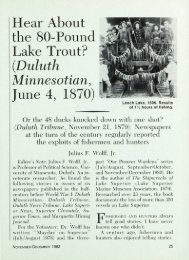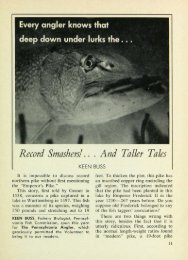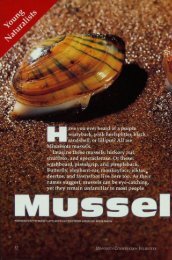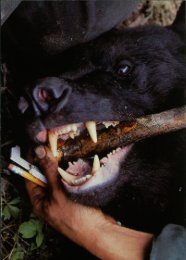try smoking your fish - webapps8 - Minnesota Department of Natural ...
try smoking your fish - webapps8 - Minnesota Department of Natural ...
try smoking your fish - webapps8 - Minnesota Department of Natural ...
Create successful ePaper yourself
Turn your PDF publications into a flip-book with our unique Google optimized e-Paper software.
Stoke It — and Smoke<br />
It!<br />
You Will Find the Flavor<br />
to Your<br />
Liking<br />
TRY<br />
SMOKING<br />
YOUR FISH<br />
Smoke and salt, either singly or in<br />
combination, have long been used in<br />
the preservation and preparation <strong>of</strong><br />
<strong>fish</strong> for human consumption.<br />
As early as 2,000 B.C., people along<br />
the River Bann in Northern Ireland<br />
smoked fresh-caught salmon over crude<br />
hearths on the marshy flats beside the<br />
river. The use <strong>of</strong> salt came somewhat<br />
later in history. Among the first to use<br />
it extensively were the Egyptians who<br />
depicted their <strong>fish</strong>-salting process on<br />
the walls <strong>of</strong> the ancient tombs.<br />
With the advent <strong>of</strong> refrigeration,<br />
brining and <strong>smoking</strong> <strong>of</strong> meat and <strong>fish</strong><br />
were no longer necessary. Nonetheless,<br />
the techniques remain today as the<br />
best methods <strong>of</strong> preparing less tasty<br />
Too many cooks? Not so when it<br />
comes to <strong>smoking</strong> <strong>fish</strong>! This article<br />
is a "composite" <strong>of</strong> the <strong>fish</strong><br />
<strong>smoking</strong> techniques and experiences<br />
<strong>of</strong> the DNR's Howard<br />
Krosch, Jack Skrypek, Walter<br />
Wettschreck, Ken Bonnema and<br />
Bruce Hawkinson, as related to<br />
associate editor Charles Wechsler.<br />
MARCH • APRI L 1974 45
<strong>fish</strong> species or those with oily flesh.<br />
These <strong>smoking</strong> "favorites" include<br />
carp, cat<strong>fish</strong>, suckers, salmon, trout,<br />
herring, tullibee and numerous saltwater<br />
species.<br />
No doubt most anglers have, at one<br />
time or another, wanted to <strong>try</strong> smokehouse<br />
cookery but were reluctant to<br />
attempt<br />
what they believe to be a<br />
complex cooking technique. However,<br />
brining and <strong>smoking</strong> <strong>fish</strong> can be as<br />
easy or as difficult as you make it. Certainly<br />
there are as many "home patented"<br />
smokehouse techniques and<br />
gadgets as there are people who smoke<br />
<strong>fish</strong>. This article is not an attempt to<br />
enlighten these self-taught<br />
"connoisseurs",<br />
but rather to present a simplified,<br />
step-by-step procedure for the beginner.<br />
The Smoker<br />
Many types <strong>of</strong> manufactured or<br />
home-made smokers will produce<br />
excellent results. Your smoker may be<br />
a wooden barrel, a large fibreboard<br />
box, steel drum or a discarded refrigerator.*<br />
Amateurs can purchase portable<br />
outdoor<br />
smokers, small electric hotplate<br />
units or even convert the patio<br />
fireplace into a suitable <strong>smoking</strong> unit.<br />
•Note: Modern, plastic-lined refrigerators<br />
should not be used as the plastic could melt<br />
with the fumes spoiling <strong>your</strong> food. Use only<br />
steel-lined iceboxes and refrigerators. Also,<br />
do not use the racks in old iceboxes. They<br />
may be cadmium-plated and food could<br />
absorb highly toxic cadmium during the<br />
<strong>smoking</strong> process.<br />
Cross-sectional view <strong>of</strong> homemade<br />
<strong>fish</strong> smoker: 55 gallon oil<br />
drum with ends removed, connected<br />
by drain tile to fire pit<br />
six feet away. Pit is one to two<br />
feet lower than smoker. Simple<br />
trench covered by sheet metal<br />
and dirt may be used to convey<br />
smoke. Move smoker cover to<br />
regulate draft.<br />
(Lack <strong>of</strong> space prohibits us from<br />
publishing detailed plans for constructing<br />
a smokehouse. However, anyone<br />
interested may write: <strong>Minnesota</strong><br />
<strong>Department</strong> <strong>of</strong> <strong>Natural</strong> Resources,<br />
Bureau <strong>of</strong> Information and Education,<br />
350 Centennial Bldg., St. Paul, Minn.<br />
55155.)<br />
The smoker should have racks,<br />
hooks (S-hooks can be made from<br />
large paper clips or coat hangers) or<br />
even spring-type clothespins to hold<br />
the <strong>fish</strong> in such a way that smoke and<br />
heat will contact all food surfaces<br />
evenly. Ventilation must be carefully<br />
controlled so the fire smoulders and<br />
smokes, rather than burning with a<br />
smokeless flame.<br />
A thermometer should be suspended<br />
from the top <strong>of</strong> the smoker. In<br />
46 THE MINNESOTA VOLUNTEER
Cleaning<br />
Fish may be cleaned any number <strong>of</strong><br />
ways. Large <strong>fish</strong> (over 5 pounds) such<br />
as Coho and Chinook Salmon, carp,<br />
buffalo, cat<strong>fish</strong> and larger trout are<br />
usually filleted or split from the back<br />
into what is called a "butterfly" cut.<br />
Very large <strong>fish</strong> should be sliced crosswise<br />
into large chunks. Smaller species<br />
such as Brook Trout, suckers, bullheads,<br />
herring and Tullibee may simply<br />
be gilled, gutted and washed.<br />
Remember: no matter how you<br />
clean the <strong>fish</strong>, always leave the skin<br />
intact, with scales on.<br />
general, the food to be smoked should<br />
be at least four feet away from a wood<br />
fire and at least two feet away from a<br />
sawdust or chip fire (see illustration).<br />
Each smokehouse expert has a<br />
favorite fuel or combination <strong>of</strong> fuels.<br />
In the beginning, <strong>try</strong> chips or sawdust<br />
from any nonresinous woods such as<br />
oak, ash, hickory, maple, beech, alder,<br />
apple or all fruit woods. Charcoal briquets<br />
can be added to maintain an<br />
even fire. Some experts use an electric<br />
or gas plate as a heat source and place<br />
a pan <strong>of</strong> dampened sawdust over the<br />
heat to create smoke.<br />
The entire <strong>smoking</strong> procedure consists<br />
<strong>of</strong> five basic steps: (1) Cleaning;<br />
(2) Brining; (3) Drying (removing excess<br />
moisture); (4) Smoking; (5) Serving<br />
or Storing.<br />
Brining<br />
The salt brine solution in which the<br />
<strong>fish</strong> is immersed acts as a preservative<br />
which inhibits bacterial growth. Most<br />
bacteria are retarded by five percent<br />
salt or higher concentrations.<br />
Any plastic, ceramic or stainless<br />
steel container may be used for brining.<br />
Do not use aluminum or galvanized<br />
pans which may corrode. For<br />
the beginner, the brining process may<br />
require some experimentation until<br />
you find the right application for each<br />
size and species <strong>of</strong> <strong>fish</strong>.<br />
A popular and simple brining procedure<br />
is to place the <strong>fish</strong> in a brine<br />
solution made in the ratio <strong>of</strong> 2 cups<br />
(about 1 pound) <strong>of</strong> noniodized, canning<br />
salt to 1 gallon <strong>of</strong> water for 1<br />
hour, stirring occasionally to remove<br />
blood and slime.<br />
MARCH • APRI L 1974 47
At left, tullibee fillets<br />
before and after <strong>smoking</strong>.<br />
Rinse the <strong>fish</strong> in cold water and<br />
place in a second brine made in the<br />
ratio <strong>of</strong> 1/2 cups <strong>of</strong> salt to 1 gallon <strong>of</strong><br />
water for 20-48 hours. Length <strong>of</strong> time<br />
in the solution will depend on size and<br />
thickness <strong>of</strong> the <strong>fish</strong>, amount <strong>of</strong> fat<br />
and degree <strong>of</strong> cure you wish to obtain.<br />
Other ingredients such as brown sugar,<br />
black pepper or bay leaves may be<br />
added during the second brining to<br />
enhance color and taste.<br />
Fish may also be brined by drysalting.<br />
Place the <strong>fish</strong> in a shallow container<br />
<strong>of</strong> fine salt and dredge, so that it<br />
is salt-covered on all surfaces. Next,<br />
place the salt-laden <strong>fish</strong> in another<br />
container where salt should be scattered<br />
between each layer <strong>of</strong> <strong>fish</strong>. Leave<br />
the <strong>fish</strong> in the salt for 6-12 hours (6<br />
hours if split or 1 2 if whole).<br />
Drying<br />
Remove the <strong>fish</strong> from the brine,<br />
rinse in freshwater and hang in a cool,<br />
breezy place for about 3 hours, or<br />
until a thin glaze, or pellicle, has<br />
formed on the surface. Do not hang<br />
<strong>fish</strong> where they are exposed to direct<br />
sunlight.<br />
Formation <strong>of</strong> the pellicle is very<br />
important in the <strong>smoking</strong> process. It<br />
helps seal in natural juices and flavors<br />
<strong>of</strong> the flesh and forms a smooth,<br />
attractive surface on which the smoke<br />
will be deposited evenly.<br />
If <strong>fish</strong> are smoked before a pellicle<br />
48 THE MINNESOTA VOLUNTEER
Using Army surplus field<br />
range materials, Howard Krosch<br />
improvised this backyard smoker.<br />
Smokehouse is on slight slope<br />
above fire pit.<br />
is formed, natural juices will seep out<br />
resulting in pools <strong>of</strong> unattractive white<br />
curd. A well-formed pellicle gives a<br />
glossy sheen to the <strong>fish</strong>, and it is dry<br />
and smooth to the touch.<br />
It is important to note that the<br />
<strong>smoking</strong> process should not be started<br />
during rainy or extremely damp<br />
weather. Cool, clear, dry days are<br />
important to the success <strong>of</strong> <strong>your</strong><br />
smokehouse cookery.<br />
Smoking<br />
Fish may be either cold smoked or<br />
hot smoked. However, cold <strong>smoking</strong> is<br />
usually not feasible for most persons<br />
because <strong>of</strong> the extended time required<br />
to complete the process. For this reason,<br />
we will present only a simplified,<br />
hot smoke procedure.<br />
First step is to hang the <strong>fish</strong>, tail<br />
up, or place them on the smokehouse<br />
racks skin side down. The racks should<br />
be sprayed with "Pam" or some other<br />
teflon substance to prevent sticking.<br />
Be sure to arrange the <strong>fish</strong> so they do<br />
not touch, and will not drip onto each<br />
other.<br />
Smoke the <strong>fish</strong> from 2 to 4 hours at<br />
low temperatures (about 110 to 120<br />
degrees) and in heavy smoke. Next,<br />
introduce higher temperatures<br />
(160-180 degrees) and little or no<br />
smoke for about 2 hours. Length <strong>of</strong><br />
cooking time in this second step depends<br />
on size <strong>of</strong> the <strong>fish</strong>, color and<br />
flavor you wish to achieve.<br />
After <strong>smoking</strong>, allow the <strong>fish</strong> to cool<br />
briefly in the smokehouse and then<br />
chill. For the ultimate in flavor, <strong>fish</strong><br />
should be eaten soon after <strong>smoking</strong>.<br />
However, smoked <strong>fish</strong> may be refrigerated<br />
for up to two weeks. Do not keep<br />
the food in air-tight containers under<br />
poor refrigeration or spoilage may result.<br />
These poor conditions favor the<br />
development <strong>of</strong> botulism toxin.<br />
If you wish to store smoked <strong>fish</strong> for<br />
a prolonged period, they may be frozen.<br />
Fish to be frozen should have the<br />
heads left on to minimize the amount<br />
<strong>of</strong> flesh exposed to the air. They<br />
should also be well-wrapped with several<br />
layers <strong>of</strong> paper to prevent the<br />
smokey odor from permeating other<br />
frozen foods.<br />
•<br />
MARCH • APRI L 1974 49






